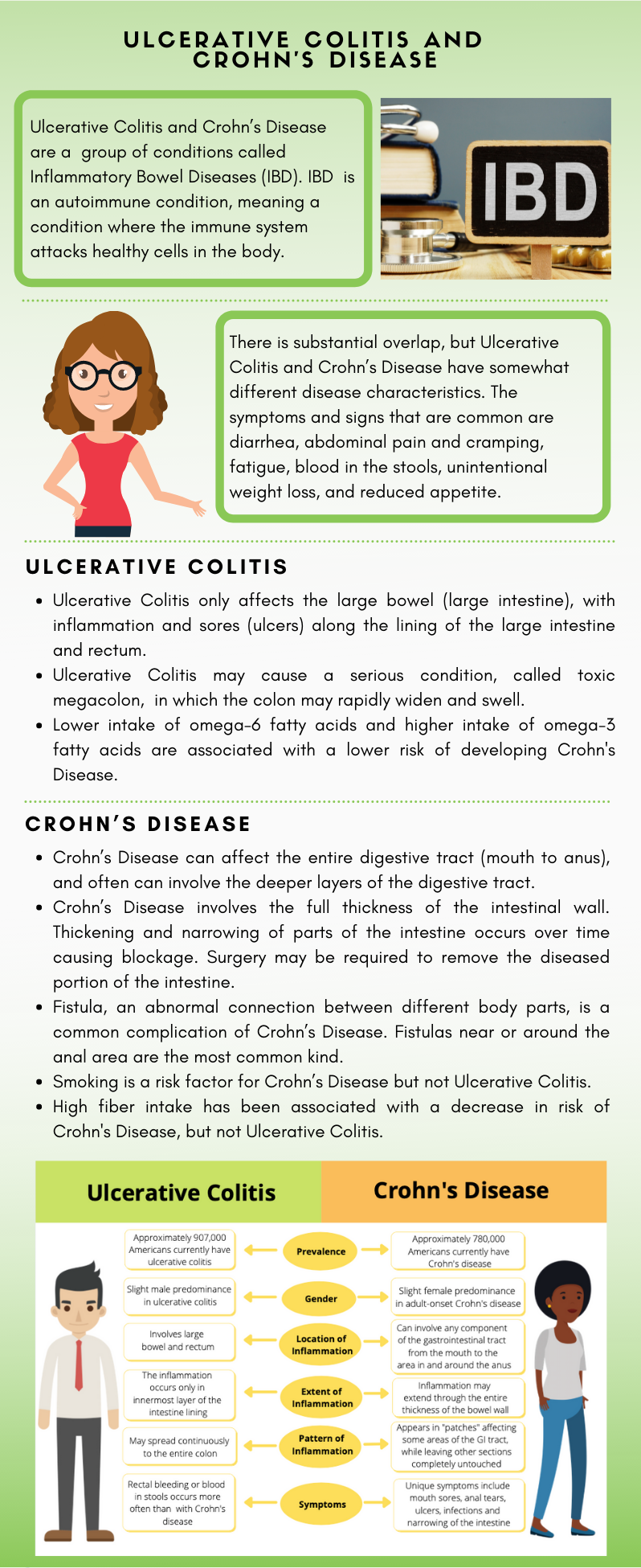
Ulcerative Colitis and Crohn’s Disease
Ulcerative Colitis and Crohn’s Disease are a group of conditions called Inflammatory Bowel Diseases (IBD). IBD is an autoimmune condition, meaning a condition where the immune system attacks healthy cells in the body.
There is substantial overlap, but Ulcerative Colitis and Crohn’s Disease have somewhat different disease characteristics. The symptoms and signs that are common are diarrhea, abdominal pain and cramping, fatigue, blood in the stools, unintentional weight loss, and reduced appetite.
Ulcerative Colitis
- Ulcerative Colitis only affects the large bowel (large intestine), with
inflammation and sores (ulcers) along the lining of the large intestine
and rectum. - Ulcerative Colitis may cause a serious condition, called toxic
megacolon, in which the colon may rapidly widen and swell. - Lower intake of omega-6 fatty acids and higher intake of omega-3
fatty acids are associated with a lower risk of developing Crohn’s
Disease.
Crohn’s Disease
- Crohn’s Disease can affect the entire digestive tract (mouth to anus),
and often can involve the deeper layers of the digestive tract. - Crohn’s Disease involves the full thickness of the intestinal wall.
Thickening and narrowing of parts of the intestine occurs over time
causing blockage. Surgery may be required to remove the diseased
portion of the intestine. - Fistula, an abnormal connection between different body parts, is a
common complication of Crohn’s Disease. Fistulas near or around the
anal area are the most common kind. - Smoking is a risk factor for Crohn’s Disease but not Ulcerative Colitis.
- High fiber intake has been associated with a decrease in risk of
Crohn’s Disease, but not Ulcerative Colitis.
| Ulcerative Colitis | Crohn’s Disease | |
|---|---|---|
| Prevalence | Approximately 907,000 Americans currently have ulcerative colitis | Approximately 780,000 Americans currently have Crohn’s disease |
| Gender | Slight male predominance in ulcerative colitis | Slight female predominance in adult-onset Crohn’s disease |
| Location of Inflammation | Involves large bowel and rectum | Can involve any component of the gastrointestinal tract from the mouth to the area in and around the anus |
| Extent of Inflammation | The inflammation occurs only in innermost layer of the intestine lining |
Inflammation may extend through the entire intestine of the bowel wall |
| Pattern of Inflammation | May spread continuously to the entire colon | Appears in ‘patches’ affecting some areas of the GI tract while leaving other sections completely untouched |
| Symptoms | Rectal bleeding or blood in stools occurs more often than with Crohn’s disease | Unique symptoms include mouth sores, anal tears, ulcers, infections narrowing of the intestine |


